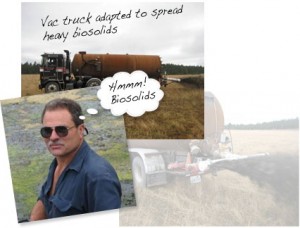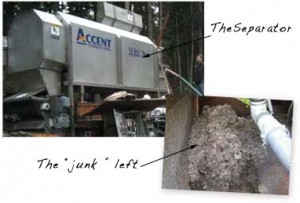Another very cool waste conversion project was started by my good friend Rolf Eriksen, owner of the Happy Acres Sewage Processing Plant located on Orcas Island in Washington State. As a side business, Rolf began trucking sewage off Orcas, and bringing potable water onto the island (in different trucks of course) to augment the groundwater that often ran dry in the summer months. With the percent of actual “waste” in sewage being very small, in essence Rolf was transporting costly loads of water nearly 400 miles off the island to be spread on fields to decompose. Seeing as the island had chronic water supply shortages, this method of disposing of the island’s sewage did not seem practical, or economical. Coupled with rising disposal, fuel and ferry costs, Rolf decided their had to be an alternative way to deal with Orcas Island’s sewage that would be better for the environment, and make some money!

After doing some research and investing in the necessary equipment, a small sewage treatment plant was developed. At first, the process consisted of simply separating the solids (paper, bottle caps feminine hygiene products etc…) from the water.
But it wasn’t simply the human waste and garbage that needed to be removed for the sewage to be turned into usable products. The problem was the heavy metals, pharmaceuticals, and toxic sanitation chemicals we flush down the pipe along with our waste. by injecting the filtered sewage with polymer compounds, the suspended solids bind together to form particles large enough to physically filter from the water.

The liquid that remains is water suitable for agricultural irrigation with biological content of 2 ppm. Most municipal water systems do not supply water this clean.
The biosolid component of this sewage is rich in nutrients, but also contains many pathogens that can cause illness and disease. These biosolids are difficult and expensive to transport to disposal facilities. As an alternative to disposal, Happy Acres decided to turn this solid waste into grade “A” fertilizer. By squeezing the biosolids through a “geotube” and removing any further water from the mixture. The remaining solids are left to compost with the addition of other organic material (leaf litter, wood chips…). The composting process generates temperatures of up to 151 degrees Fahrenheit, which, when harnessed, heats a nearby greenhouse.

As with most forms of waste, sewage is not an end product. It is a critical part of system that needs to be addressed, and not simply forgotten about after “the flush”. Rolf has not invented any new technology to carry out the treatment of raw septage. However, it is the fact that he has brought together different processes to show that waste can be turned into many useable products that benefit both humans and the environment.
Sewage is something that most people will be more than happy to keep out of sight and out of mind. But it should be looked upon as a crude substance, waiting for it’s usefulness to be realized.
Tags: No Comments


0 responses so far ↓
There are no comments yet...Kick things off by filling out the form below.